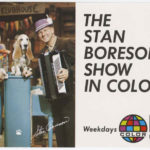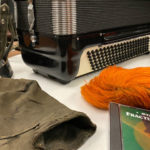Stan Boreson’s accordion comes home to Seattle
Mar 4, 2020, 8:02 AM | Updated: 8:35 am
It’s been a little more than three years since Stan Boreson died at the age of 91.
If you’re of a certain age and grew up around here, you know that Everett-born Boreson was the self-proclaimed “King of Scandinavian Humor.” He had a kids’ show on KING TV for 18 years, with a human co-star (his friend Doug Setterberg) and a somnolent Basset hound named Nomo.
He put out a slew of Scandinavian-themed comedy records, including the 1970 classic, “Yust Go Nuts at Christmas.” And he performed live with his accordion thousands of times all over the Northwest from the 1940s to the 2010s, appearing at everything from birthday parties to conventions to lodge meetings.
And if all that weren’t enough, “King Stan” appeared on both the Lawrence Welk Show and Prairie Home Companion. That’s not a claim that too many people can make; in fact, Stan may be the only one.
Though he’s been gone for three years, the big news this week is that Stan Boreson’s accordion has come home.
After a nearly thousand-mile journey from Southern California, a truck delivered the accordion a few days ago to the archive facility that MOHAI, the Museum of History & Industry, maintains in the Georgetown neighborhood. With the blessing of MOHAI curator Kristin Halunen, KIRO Radio invited local musician, theatre guy – and accordion player, of course – Rob Witmer to come to the archives and make sure the priceless artifact had arrived in one piece.
With Witmer watching, Halunen carefully sliced open the tape sealing the cardboard shipping container, and then opened the leaves of the box. She pulled away the bubble wrap, revealing a black leatherette case that looked as if it were roughly large enough to hold a snow tire.
Witmer helped Halunen lift the case from the box and the two placed it gently on the table in the center of the curatorial offices at the MOHAI facility. Witmer undid the two latches and opened the hinged lid of the velvet-lined case. The accordion wasn’t yet visible; it was still covered by velvet dustcover. Tucked into the case was one of Boreson’s Christmas CDs, plus a hat and a bright orange wig.
As Rob Witmer pulled back the velvet dustcover, the accordion was finally revealed.
“These accordions are top-of-the-line,” Witmer said, clearly admiring the vintage instrument from the point of view of a seasoned musician. “Petosa accordions are made right here in Seattle, [by] third-generation accordion makers. I play a Petosa as well.”
“This is really exciting,” Witmer continued, as he closely inspected the keys, buttons and knobs that seem to cover every available surface. “And these accordions, they hold up. They’re made to last generations,” he said.
Though it still lay in its case, Witmer’s visual inspection made it clear that the accordion had arrived from the Golden State intact.
But what, exactly, was a Northwest icon’s musical instrument doing so far from home?
“We brought it down to California [after he passed away] because I just couldn’t part with it yet,” said Stan’s daughter Ann Boreson last week, from her home in Manhattan Beach. “It was one of the things that I know was the closest thing to my dad.”
“And so I just wanted to hold onto it for a minute,” Ann Boreson said.
That “minute” ended up stretching into a few years.
“Then I started to think about it, and I thought with the salt air down here . . . I don’t want anything to happen to it,” Boreson said. “I also thought, to be honest, it was kind of selfish of me, because it should be enjoyed by people that enjoyed him. So then I thought there was only one place that it should go.”
And that one place was MOHAI, which has collected materials related to Stan Boreson – and other local performers including KIRO TV’s J.P. Patches and KOMO TV’s Captain Puget – for decades. MOHAI also hosted each December, from 2000 to 2004, the “Northwest TV Holiday Reunion,” which always featured Stan Boreson performing holiday parody songs on his Petosa accordion. The lakeside museum also hosted a rollicking public memorial for Boreson on March 5, 2017.
Back at the MOHAI archives, Witmer prepared to get a closer look at the prized accordion. As he readied it for a “test drive,” Witmer, who’s worked in musical education for kids, launched into a tutorial.
“I’m gonna take it out of the case,” Witmer said. “It looks like it’s in pretty good shape.”
At that instant, the accordion made a short but clearly audible squeak.
“Oops, made a little sound there,” Witmer said with a chuckle, as Halunen and a few other MOHAI employees now gathered in the room looked on. “That’s what we want to hear.”
Witmer undid a snap, and pulled on one side of the accordion to expand the bellows, or the part of the instrument that creates the air pressure which, in conjunction with the reeds and valves, is responsible for the distinctive accordion sound.
“When I explain the accordion to kids, I always tell them to first listen very carefully and you’ll hear this sound,” Witmer said. “Accordions breathe just like we do.”
Sure enough, as Witmer manipulated the bellows, the accordion sounded like it was respirating.
“Gotta take a big breath,” Witmer said, expanding the bellows again and starting to sound like either a gymnastics coach or a chatty auto mechanic. “[And then] let it out. Sounds good . . . bellows are nice and tight . . . take a little bit of resistance there . . . and then let’s get a sound going over here,” he said, pressing on the piano-like keys and turning the bellows’ breath into a reedy-sounding note.
To many of those people of a certain age who remember him, Stan Boreson is more than just a guy who played the accordion on TV. He’s one of those iconic figures that you just can’t imagine not being a part of your childhood – or, in many cases, your adult years, too – around Puget Sound.
Ann Boreson says her dad is symbolic of what this region means, at its most elemental level, to so many people.
“The legacy is that there’s a core value that all those guys” – like Stan Boreson and J.P. Patches – “brought to the Northwest,” Ann Boreson said. “And you don’t want [people] to forget that core value of who we are, and that the state of Washington was just such a cool place to grow up.”
Witmer was now putting the thick leather straps of the accordion over his shoulder. By now, Ann Boreson had joined the party to listen in from California and was on the speaker phone.
“As you remember there was a theme song, right?” Witmer said to Ann Boreson as Kristin Halunen and the other MOHAI staff looked on. “I’m going to have to look at the lyrics. Did he write those?”
“I think so,” Ann Boreson said.
With that, Witmer launched into the “KING’s Klubhouse” theme song:
Zero dacus, mucho cracus, hallaballu-za bub
That’s the secret password that we use down at the klub
Zero-dacus, mucho-cracus, hallaballu-za fan
Means now you are a member of KING’s TV Klub with Stan!
Once the applause and cheering died down, Witmer pronounced Stan Boreson’s accordion fit as a fiddle. He also showed MOHAI’s Kristin Halunen how to occasionally “exercise” the bellows to keep them in good shape.
“This is an air button here where my thumb is,” Witmer said. “That allows you to move the bellows without playing a note, right? So you could just put your thumb there and just kind of move this back and forth . . . get some air in there [and] exercises those a little bit.”
MOHAI has not set a specific date, but does plan to display the instrument at the museum at Lake Union Park. Stan Boreson’s accordion will likely appear in MOHAI’s permanent Seattle history exhibit, within the section devoted to local children’s TV show hosts.
Ann Boreson picked the right place to ship that box from California. Her father, Stan Boreson may be gone, but his spirit and his music – and now, his accordion – will live on.





















